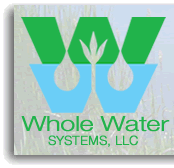CWB | Recirculating Filter-bed Bioreactor | VBR
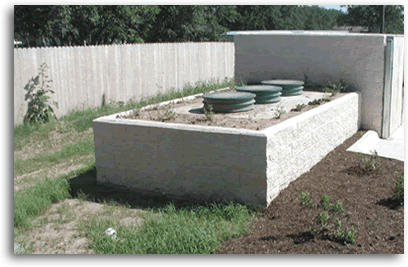 
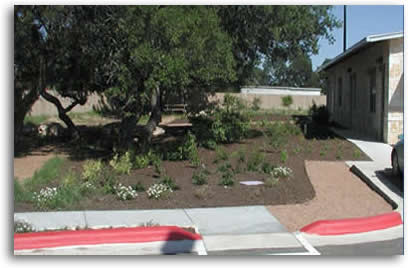 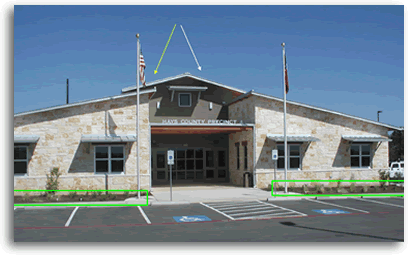
Hays County Precinct 4 Building - Hays County, TX
By integrating the “waste” water management function with the water supply function, treating the “waste” water close to where it is generated and applying it to nearby non-potable reuse opportunities, the demand from the “original” water supply source would be significantly reduced.
Further, by harvesting another form of typically wasted water –roof runoff –the demand on the “original” water supply source could be further reduced. This integrates the stormwater management function with water supply.
Water can also be “harvested” off other surfaces to hold more water on the land, instead of creating an increased volume of runoff exported from the site due to the addition of impervious cover. This is essentially the practice of Low-Impact Development (LID). This water contributes to maintenance of long-term soil moisture and may enhance aquifer recharge and/or stream baseflow. This too integrates stormwater management with water supply.
RFB system for treatment of domestic wastewater. Subsurface irrigation system connected to RFB treatment.
8,600 gallon rainwater cistern connected to subsurface irrigation.
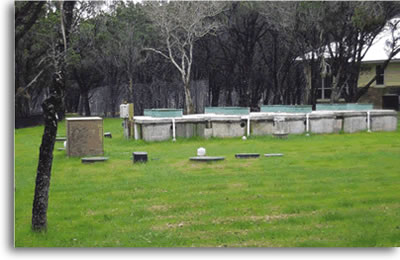
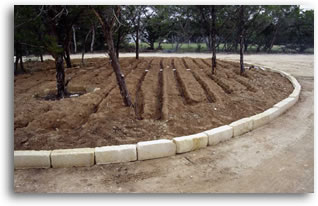 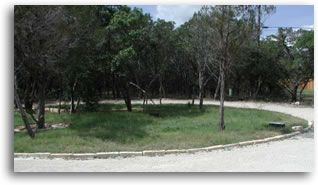
Elysium Residential/Commercial Condominium
David Venhuizen planned and designed this collective wastewater system to serve 5 houses and 2 small commercial buildings. One of the commercial buildings is a realtor’s office and the other is an organic cookie bakery and small bistro. Primary septic tanks were installed to intercept the raw wastewater flow from the building, and the effluent out of these tanks is transported to the treatment center in 2-inch effluent gravity sewers. The treatment center employs a high performance biofiltration (recirculating gravel filter) system, to provide a consistently high quality effluent and cope with the varying flows, due to intermittent occupancy of the houses and the variable operating schedule of the bakery and bistro. The reclaimed water is distributed to four different areas around the property, irrigating grounds beautification and a garden area.
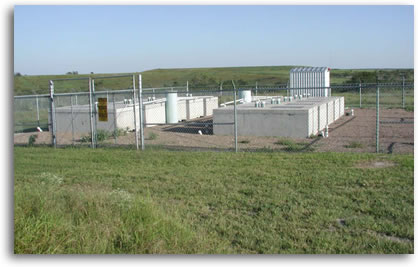 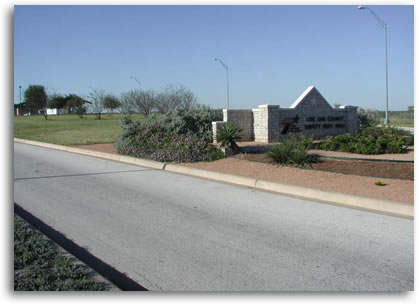
Texas Department of Transportation
David Venhuizen designed a high performance biofiltration (recirculating gravel filter) treatment system and drip irrigation effluent dispersal system for two rest stops on Interstate Highway 37 between San Antonio and Corpus Christi, one serving northbound lanes and one serving southbound lands. These are the most highly used rest stops in Texas. A significant design challenge was to assure that the system could respond to highly variable flows generated by variable pattern of rest stop usage. The treatment system incorporated tanks used in the pre-existing wastewater system, adding only the filter bed containment tanks and a reclaimed water holding tank.
The subsurface drip irrigation system was integrated into landscaping plan. It composed the drip irrigation for the portion of the “island” between the truck parking area and the auto parking area form the entry end of the rest area to the restroom building, which lay about halfway between the entry and the exit ramps. The other half of the “island” is irrigated through a surface spray system, also designed by Venhuizen, which is fed by the potable water system. The two irrigation systems mesh seamlessly, using a unified control system. The drip field feed system provides capability to add makeup water to provide irrigation in excess of what is produced by the wastewater flow in the peak irrigation season.
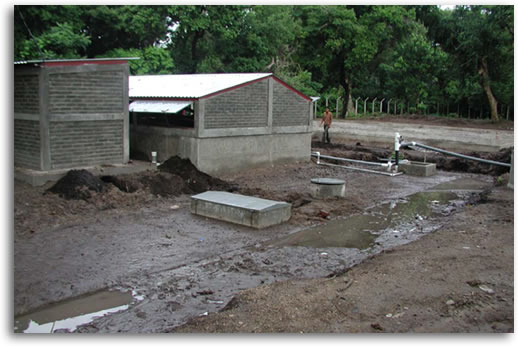 CARE–El Salvador CARE–El Salvador
This project commenced with a seminar presented by David Venhuizen in San Salvador to a group of interested engineers, government officials and aid agency workers on the decentralized concept as a way to provide more affordable wastewater management in El Salvador, and on the high performance biofiltration as the treatment method most cost efficient and readily manageable in that concept. This was part of an effort funded by a U.S. AID grant. The intention was to implement a small demonstration-scale project, perhaps serving 10 houses. However, an alliance was formed with CARE-El Salvador to leverage this grant with other funds provided to CARE to implement a wastewater system in a village on the Guatemalan border. While it was planned to provide service to this village with a conventional collection system and a lagoon treatment system, an isolated neighborhood in a separate drainage area was selected for a larger scale demonstration of a decentralized concept system.
This portion of the village had 80 homes currently in place, with the potential for up to 120 at full buildout. David Venhuizen instructed CARE personnel in the design of effluent sewers and treatment system, provided design details for the collection and treatment systems, directed the system layout, advised on system construction, and was a hands-on participant in the completion and commission of the system. The collection system consists of septic tanks receiving flow from the houses, with effluent from these tanks fed to the treatment center through a small-diameter effluent sewer system. The treatment system is composed of both a high performance biofiltration unit, using non-woven polypropylene geotextile fabric media, and a subsurface flow wetland unit, so that both concepts could be demonstrated. Effluent is routed to reuse projects that produce income for the residents.
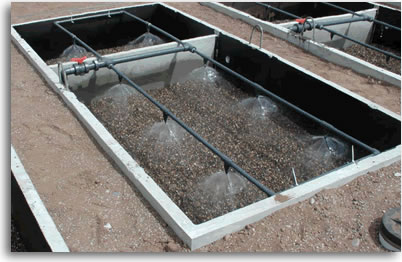 Santuario de Chimayo Wastewater Treatment Unit Santuario de Chimayo Wastewater Treatment Unit
David Venhuizen designed and provided construction observation services for a wastewater treatment system to serve the Santuario de Chimayo. This chapel, located in Chimayo, New Mexico, is the largest Roman Catholic pilgrimage destination in the western hemisphere. The seasonal pattern of visitation, and in particular a severe peak in Holy Week, and a requirement to produce an effluent with an effluent nitrogen concentration of <15 mg/L posed a challenge. The high performance biofiltration (recirculating gravel filter) treatment concept was chosen to cope with the operating conditions, to produce the required quality of effluent, consistently and reliably. As a sub-consultant to the prime consultant, Venhuizen created all of the design drawings for the wastewater system, utilizing standard, off-the-shelf septic tanks, modified to suit, available in the region. This included siting the treatment center on a remote corner of the site, requiring placement of primary tanks and an effluent pump station near the restroom building, located next to the chapel. The nominal design flow rate of the system is 2,500 gallons/day. The reclaimed water is distributed in parking lot islands in a subsurface drip irrigation field (designed by another sub-consultant) to beautify the grounds.
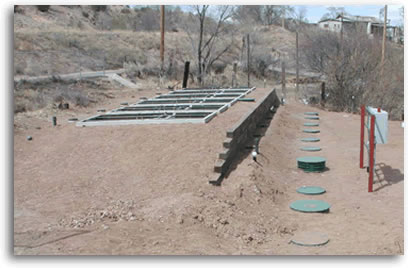 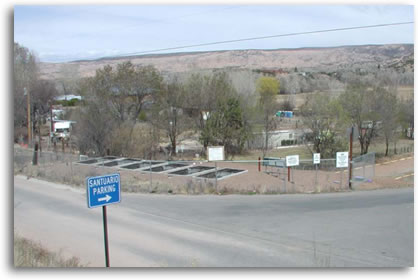
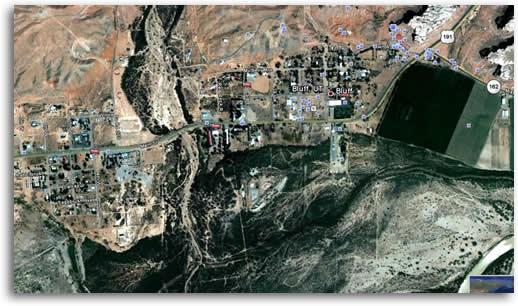 Bluff, Utah - Wastewater Facility Plan Bluff, Utah - Wastewater Facility Plan
In this project, David Venhuizen generated and analyzed options for decentralized concept wastewater management systems to serve Bluff, a small community currently served by individual on-lots systems only. The community includes several businesses that serve a tourist economy and experience large seasonal fluctuations in wastewater flow. These options include:
•
Centrally managed on-lot systems plus clusters for the commercial generators and lots on which a code-compliant on-lot system could not be sited, routing wastewater from those lots to collective dispersal systems, including options with low-pressure-dosed dispersal fields for septic tank effluent and with high quality pretreatment prior to drip irrigation dispersal, depending on findings of need to protect the shallow aquifer from nitrate pollution.
•
A “small-scale” cluster system collectivizing all properties into several treatment centers spaced around the community, with high quality pretreatment prior to drip irrigation dispersal, optionally locating the drip dispersal fields to serve an irrigation reuse function on public greenspace and/or private property.
•
A “large-scale” collective system routing wastewater from all properties to one or two treatment centers, with high quality pretreatment, routing effluent to stream discharge or to drip dispersal systems, which may optionally be located to serve an irrigation reuse function on public greenspace and/or private property.
The project was conducted with a partner firm that generated and analyzed more “conventional” management options. The community chose the decentralized concept options as the most favored strategies, and the facility plan was been completed on that basis. The project is currently about to enter the design phase. The treatment technology favored for use in the decentralized concept options is a variant of the packed bed filter (recirculating “sand” filter). All wastewater collection would use effluent gravity sewers.
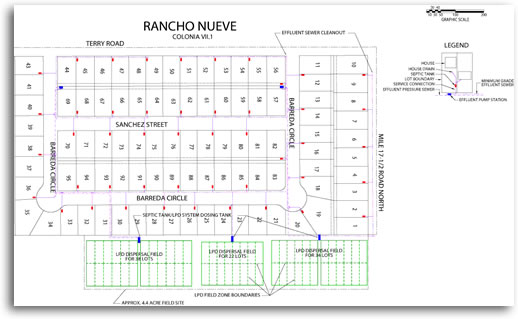 Hidalgo County (Texas) Colonias Projects Hidalgo County (Texas) Colonias Projects
These projects were conducted under the Economically Distressed Area Program (EDAP) of the Texas Water Development Board (TWDB). The prime contractor on these projects was Carter & Burgess, Inc. Venhuizen performed all work dealing with "innovative/alternative" management options as a subcontractor to Carter & Burgess. Venhuizen participated in three projects dealing with Hidalgo County colonias: the Rural Colonias Project, the scoping phase of the Regional Colonias Project, and the facility planning phase of the Regional Colonias Project.
The Rural Project entailed detailed system planning for 4 selected colonias, containing 22, 72, 83 and 84 lots. Venhuizen prepared system plans and generated cost estimates for the following options for each of these colonias:
- Small-scale collective systems in which effluent from septic tanks on each lot flows through small diameter gravity sewers to multiple low-pressure-dosed (LPD) dispersal fields scattered around the perimeter of the colonia.
- Small-scale collective systems in which effluent from septic tanks on each lot flows through small diameter gravity sewers to multiple sand filter treatment units, the effluent from which is piped to one or more points where it is disinfected and discharged into an irrigation drainage canal.
- Large-scale collective systems in which effluent from septic tanks on each lot flows through small diameter gravity sewers to one large LPD dispersal field.
- Large-scale collective systems in which effluent from septic tanks on each lot flows through small diameter gravity sewers to a single sand filter treatment plant, the effluent from which is disinfected and discharged into an irrigation drainage canal.
- Large-scale collective systems in which effluent from septic tanks on each lot flows through small diameter gravity sewers to a single constructed wetland (gravel marsh) treatment plant, the effluent from which is disinfected and discharged into an irrigation drainage canal.
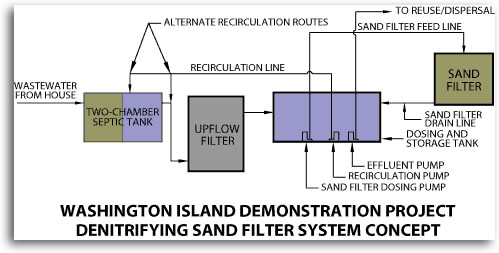 Washington Island, Wisconsin - Demonstation Project Washington Island, Wisconsin - Demonstation Project
This project was a Facility Plan funded by the state of Wisconsin Department of Natural Resources (DNR) which was conducted by David Venhuizen, P.E., with assistance by Baudhuin Incorporated of Sturgeon Bay, Wisconsin. The facility planning process for the Town of Washington commenced prior to Venhuizen's involvement. The original draft of the plan concluded that the Town should install a central treatment station with discharge into Green Bay, and should use holding tanks and a pump-and-haul operation as its "sewer" system. There was broad dissatisfaction with the recommended course of action, due to its cost, to the distribution of those costs among the population, to the great increase in pumper truck traffic which it would entail, and because it would result in a discharge into prime fishing waters.
This prompted the Town to investigate whether a strategy of using "improved" on-site and/or small collective systems would be a viable alternative to wholesale installation of holding tanks. Any such systems would have to cope with site restrictions-including shallow depth to groundwater and/or bedrock and otherwise "unsuitable" soils-which abound on the island, and would have to accommodate the island's large seasonal population and operate properly through the island's harsh winters. In October of 1990, Venhuizen was asked to make a presentation on such an approach to the Town's Wastewater Advisory Committee. That committee then recommended to the Town Board that Venhuizen be hired to explore this "decentralized" management approach.
By agreement with state regulatory agencies, Venhuizen was required to propose and justify treatment and dispersal systems, then to design several "demonstration" systems, which the Town would install and monitor in order to "prove up" these systems for more general use. Of particular concern to the state at that time was nitrate pollution from on-site systems. Venhuizen submitted the following reports as justification for proceeding with the demonstration program:
- A detailed review of the background and capabilities of candidate treatment trains. These included various combinations of septic tanks, anaerobic upflow filters, gravel marshes, and intermittent sand filters.
- A discussion of appropriate design flow rate criteria for these systems.
- A review of system management practices. (Click here to see this paper)
- A proposed protocol for water quality monitoring under the demonstration program.
- A preliminary cost effectiveness analysis of the decentralized system versus the previously proposed central station and pump-and-haul option
|
